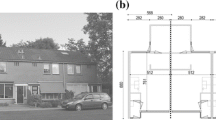Abstract
The response of autoclaved aerated concrete confined masonry buildings to seismic ground motion has been studied. Three 1:4 scale models of residential buildings with the same distribution of walls in plan but different types of floors and number of stories have been tested on a uni-directional shaking table. Lightweight prefabricated slabs have been installed in the case of the three-storey model M1, whereas reinforced concrete slabs have been constructed in the case of three-storey model M2 and four-storey model M3. Model M1 was subjected to seismic excitation along the axis of symmetry, whereas models M2 and M3 were tested orthogonal to it. Typical storey mechanism, characterised by diagonal shear failure mode of walls in the ground floor in the direction of excitation has been observed in all cases. Taking into consideration the observed behaviour, a numerical model with concentrated masses and storey hysteretic rules has been used to simulate the observed behaviour. Storey resistance curves calculated by a push-over method and hysteretic rules, which take into account damage and energy based stiffness degradation hysteretic rules, have been used to model the non-linear behaviour of the structure. Good agreement between the experimentally observed and calculated non-linear behaviour has been obtained.
Similar content being viewed by others
References
Alcocer SM, Arias JG, Flores LE (2004) Some developments on performance based seismic design of masonry structures. In: Fajfar P, Krawinkler H (eds) Performance-based seismic sesign. Concepts and implementation. PEER Report 2004/2005, pp 33–44, Berkeley
Bertero V, Uang CM (1992) Issues and future directions in the use of an energy approach for seismic resistant design of structures. In: Fajfar P, Krawinkler H (eds) Nonlinear seismic analysis and design of reinforced concrete buildings. Elsevier, London, pp 3–22
CEN (2004) Eurocode 8: design of structures for earthquake resistance, Part 1: general rules, seismic actions and rules for buildings. EN 1998-1:2004. CEN, Brussels
Costa AA, Penna A, Magenes G (2011) Seismic performance of autoclaved aerated concrete (AAC) masonry: from experimental testing of the in-plane capacity of walls to building response simulation. J Earthq Eng 15(1): 1–31
Earthquake resistant design of load-bearing Ytong structures, Manual (2004) Xella Porobeton SI (in Slovene)
Harris GH, Sabnis GM (1999) Structural modeling and experimental techniques. CRC Press, Boca Raton
Langhaar HL (1951) Dimensional analysis and theory of models. Wiley, New York
Magenes G (2006) Masonry building design in seismic areas: recent experiences and prospects from a European point of view. In: The 1st European conference on earthquake engineering and seismology. CD-ROM, Geneva, Keynote Address K9: paper 4009
Park YJ, Reinhorn AM, Kunnath SK (1987) IDARC: inelastic damage analysis of reinforced concrete frame—shear-wall structures. Tech Rep NCEER-87-0008. National Center for Earthquake Engineering Research, Buffalo
Schöps P, Jäger W (2009) Confined masonry—a chance to improve the load bearing capacity. In: 11th Canadian masonry symposium, CD-ROM, Toronto
Tanner JE, Varela JL, Klingner RE, Brightman MT, Cancino U (2005) Seismic testing of autoclaved aerated concrete shearwalls: a comprehensive review.. ACI Struct J 102(3): 374–382
Tomaževič M (1978) Improvement of computer program POR. Report ZRMK-IK, Ljubljana (in Slovene)
Tomaževič M, Velechovsky T (1992) Some aspects of testing small-scale masonry building models on simple earthquake simulators. Earth Eng Struct Dyn 21(11): 945–963
Tomaževič M, Lutman M (1996) Seismic behavior of masonry walls: modeling of hysteretic rules. J Str Eng ASCE 122(9): 1048–1055
Tomaževič M (1999) Earthquake-resistant design of masonry buildings. Imperial College Press, London
Tomaževič M (2007) Damage as a measure for earthquake-resistant design of masonry structures: Slovenian experience. Can J Civ Eng 34(11): 1403–1412
Tomaževič M, Weiss P (2010) Displacement capacity of masonry buildings as a basis for the assessment of behavior factor and experimental study. Bull Earthquake Eng 8: 1267–1294
Tomaževič M, Gams M (2010) Seismic behavior of Ytong houses: a shaking table study. Research Report ZAG P 0891/08-650-2, Ljubljana
Turnšek V, Čačovič F (1971) Some experimental results on the strength of brick masonry walls. In: Proceedings 2nd international brick-masonry conference. British Ceramic Society, stoke-on-trent, pp 149–156
Author information
Authors and Affiliations
Corresponding author
Rights and permissions
About this article
Cite this article
Tomaževič, M., Gams, M. Shaking table study and modelling of seismic behaviour of confined AAC masonry buildings. Bull Earthquake Eng 10, 863–893 (2012). https://doi.org/10.1007/s10518-011-9331-x
Received:
Accepted:
Published:
Issue Date:
DOI: https://doi.org/10.1007/s10518-011-9331-x




